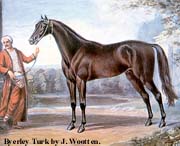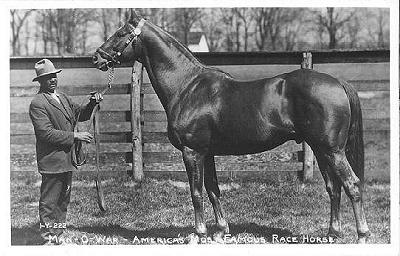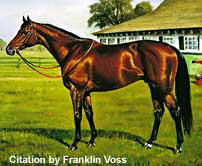
Thoroughbred Profiles
________________________________________________________________________

Byerly (or Byerley) Turk
The first of the three
founding fathers of the breed to appear on the English
scene was a tough Turkish
charger. Where he came from is mystery. Some say he was one of the
spoils of war, and some say his forebears were Arab, not
Turk.
What is known is that he was foaled about 1679 and was
supposedly captured from the Turks at the siege of Buda and imported to England
by Captain Byerly. The captain rode him at the Battle of
the Boyne ("the one big battle in Ireland"
mentioned below?) and in King
William's War (about 1689), and that he and the captain survived the one big battle in Ireland
and returned in fine fettle to England. There as the Byerly Turk, he sired
some famous race horses, being used as a sire at least as late as 1698.
One source said that this horse might
have been an Akhal-Teke.
I had never thought about that but, come to think of it, none of the paintings
of the foundation stallions look like pure Arabs
to me!
________________________________________________________________________

Darley Arabian
The second of the three was a magnificent bay with a white blaze down his face and three white feet. A traveling merchant named Thomas Darley discovered him in the Syrian desert. By some power of persuasion he did the impossible; he convinced an Arab tribe to sell the stallion. And before the Arabs could change their mind, the handsome bay was bound for Buttercramp in England. (At least one source states that he was bought in Aleppo, Syria, which would coincide with this story.) He arrived in England in 1700, at the age of four. Descendants of the Darley Arabian are renowned for their swiftness. I have even heard that this horse might have been a Turkmen horse! (Note: Something I just read implied that even the "Barb" and "Turkmen" horses are descendants of the Arab. I really have to object to this, but since I really am not on expert on genetics, I will wait to say more!)
________________________________________________________________________

Godolphin Barb (or Arabian, or stallion!)
The Godolphin Arabian was a little stallion
who sired big. His clear bay coat was ticked with gold, and the only white
marking was a spot on his off-hind heel, the emblem of swiftness. He was a
royal gift from the Sultan of Morocco
to the boy king of France, but his
deerlike smallness made him the laughingstock of the noblemen. They
shunted him out of sight, not caring at all when he was sold to a brutal wood
carter. Horse-whipped through the streets of Paris, he was finally bought
by a Quaker who shipped him to England, and there he became the favorite
stallion of the Earl of Godolphin, hence his name. Although the fiery
little Arabian
never started in a race, his name is found today in the pedigree of
nearly all race horses. (Problem with this paragraph: It was taken
from a book that is partly fictional; as much as I love this story, I haven't
decided how much of it to believe. Other sources have confirmed a few
things about him, though--at any rate, that he was a brown bay, about 15 hands,
and foaled about 1724.)
This stallion appeared about 20 years later
than the other two. There is quite an argument over whether this was a true
Barb
or an Arab
from the Barbary coast. I like to think he was a Barb,
but then I'm prejudiced! If you can tell by the painting, good luck,
because, as I stated above, none of these three paintings look like pure Arabs
to me! I usually just call this the Godolphin
stallion so as not to pick a fight! (I will add, however, that some
sources have actually stated that most authorities consider him to be a Barb;
how many "most" is may be in question, but certainly I'm not the only one that
thinks so.)
In Windsor Castle there is a painting of the Godolphin
Arabian (I don't know if that is the above picture!), and lettered around the
frame are these words: "Esteemed one of the best foreign horses ever
brought into England. He is allowed to have refreshed the English blood
more than any foreign horse ever yet imported." (My last two-cents
worth! If this quote is true, and this horse proves to be a Barb,
then the Arabian
could not be the most influential breed! Thus,
anyone arguing about this stallion has a very important bone to pick for their
respective breed!)
________________________________________________________________________

Eclipse
Great-great-grandson of the
Darley Arabian, well named Eclipse, dimmed the brightness of every other racing
horse. He was never beaten, "never had a whip flourished over him or
felt the rubbing of a spur--outfooting, outstriding, outlasting every horse that
started against him."
In all fairness, however, Darley's Arabian cannot be given
full credit for the speed of Eclipse. On his mother's side he was closer
to the Godolphin Arabian, the third of the Oriental trio.
Eclipse was so named from having been foaled on the day of a
solar eclipse, April 1, 1764. He was bred by the Duke of Cumberland, and
was at first considered so ordinary that he was not raced until he was five
years old. He only raced for seventeen months, but was never even closely
threatened, let alone beaten and earned his new owner, Colonel O'Kelly, more
than $125,000, a tremendous sum in those days.
Eclipse was probably only between 15 and 16 hands at the
withers, if that, but may have been higher at the croup and therefore faster
than one would expect a horse of that size to be. He is said to have had a
stride of 25 feet (only 3 feet shorter than the great Man o' War!) and
supposedly once ran a 4-mile race in 6 minutes, 2 seconds. This last is
probably inaccurate, since the great Lexington established an official record
for the same distance in 1855 at 7 minutes, 19 3/4 seconds. This, however,
does nothing to lessen the greatness of Eclipse as probably the fastest horse of
his time.
________________________________________________________________________

Man o' War
In brief, he won 20 out of 21 races and his groom called him "the mostest horse that ever was." I will add more later as I have time but I felt that I needed to go on and get a picture of him on here. That is his groom in the picture; I have his name somewhere, but I don't feel like looking for it right now.
________________________________________________________________________

I actually know practically nothing about Citation, except of course that he was a great racehorse, so will have to do some research and get more info on this page, but wanted to at least include his picture for now.